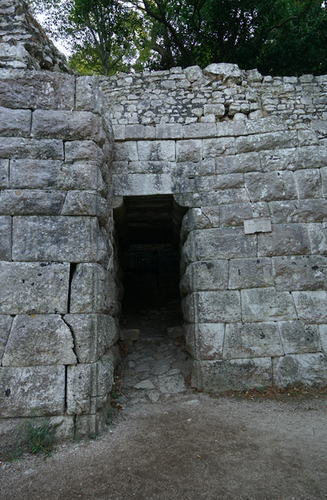Lake Gate (or Porta Scea)

The gate is in the northeast side of the lower circuit wall. It was one the access to the acropolis from the northern bay during Classical and Hellenistic Age. Ugolini reserved great importance to the Lake Gate (or Porta Scea, as he called it) because it was the place where Aeneas was thought to have landed in Butrint.
Ceka described it as a variation of the front entrance gate, which is common for pre-urban settlements, since it guarantees a better protection. The gate is in a good state of conservation, though included in the Medieval wall circuit: the threshold and jambs that preserve the recess for the doors and for the closing bars in wood are still visible. The façade is formed by large trapezoidal, roughly worked, stone blocks. The opening is not wide, and the main beam are held up by large shelves. The two walls forming the passage are not parallel and at the inner end of the passage there is a U-shaped indent in the southeast wall that is not matched in the opposite. The structure of the gate would allow just a little number of attackers entering from outside, and an higher number of defenders staying in the rear area. The gateway is roofed by a monolithic stone ceiling supported by stone consoles with curved undersides, while its inside has small and rectangular stones. The floor ascends as it enters the city, thus dividing the passage in the gateway in two parts. On the left side of the entrance, the boundary wall forms a protrusion of 2 m, forming a sort of bastion about 20 m long.
Bibliography on the subject
- Ceka N, "La fortification antique de Butrint et le territoire des Prasaibes" in Monumentet, vol. 12, 1976, pp. 27-48
- Giorgi E., Lepore G., “Comparing Phoinike and Butrint. Some remarks on the walls of two cities in Northern Epirus” in Caliò L. M., Gerogiannis G. M., Kopsacheili M., Fortificazioni e società nel Mediterraneo occidentale, Albania e Grecia settentrionale, Roma, 2020, pp. 153-181
-
Hammond N. G. L., Epirus. The geography, the ancient remains, the history and the topography of Epirus and adjacent areas, Oxford, Clarendon Press, 1967, pp. 101-104
-
Karaiskaj G., Crowson A. (edt), The fortifications of Butrint, English edition of Butrinti dhe fortifikimet e tij (Tirana 1986), London-Tirana, Butrint Foundation, 2009, pp. 36-38
- Martin S., "The topography of Butrint" in Hodges, Bowden and Lako, Byzantine Butrint: excavations and surveys 1994-99, Oxford, 2004, pp. 76-103
- Ugolini L. M., Butrinto. Il mito di Enea. Gli scavi, Istituto grafico tiberino, 1937, pp. 117-119
- Ugolini L. M., L‘acropoli di Butrinto, Roma, 1942, pp. 49-56